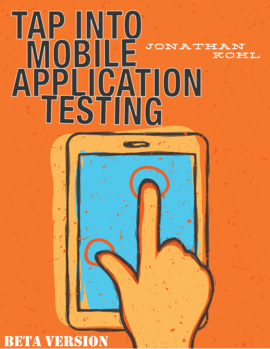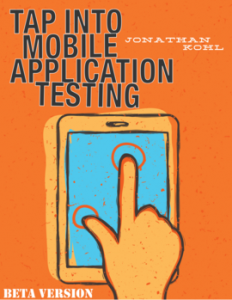I wrote an article for Better Software magazine this month called “Software Testing is a Game”, available here in PDF format. I wrote about using gamification as an approach to analyze and help make software testing more engaging. I encouraged readers to apply some ideas from gamification to their own testing efforts. Now, why would I do a thing like that? And what do I mean by using game mechanics when we are testing? Games are all well and good, and I may enjoy them, but we are talking about serious work here, why would we make it look like a game?
Let me give you a bit of background information.
I was working with my friends Monroe Thomas and David McFadzean on product strategy when they started bringing up my gamification design ideas. I use gamification in mobile app design to help them be more engaging for users. That doesn’t mean that I make an app look like a game, it means I use ideas from games to help make the app more interesting and easier to use. However, we weren’t talking about mobile apps, so I was a bit surprised. They pointed out that the same concepts that make gamification in mobile apps apply to other apps, after all, David and I even wrote an article about using gaming when creating software processes. Why couldn’t I use those ideas in a product strategy meeting for something else?
Good point.
In fact, they even urged me to look at some of my other prior app designs, they felt I would find gamification-style aspects in those as well, because I always worry about making apps more engaging. Once I started thinking about the implications of what they were saying, an entire new world of possibility opened up. I felt like they had just kicked open a big door of perception for me.
But wait a minute. What is this business about games? Well, the thing with gamification is that when I use those tools correctly in an app, you don’t know it is there. I don’t put childish badges and leaderboards in a productivity app and then say: “Look! gamification at work!” for example. Andrzej Marczewski describes gamification mechanics in terms we can relate to in his blog Game Mechanics in Gamification as: Desired Behavior, Motivation and Supporters.
Andrzej uses a game format to illustrate his point, but it should be obvious that these three themes are not limited to games. Where game designers shine, and where policy wonks and enterprise or productivity designers tend to fail is in the structure around desired behavior. Too often, we just expect people to excel in a work place environment with little support. Games on the other hand tickle our emotions, they captivate us, and they encourage us to work hard at solving problems and reaching goals.
Framing something like software testing in terms of gaming, and borrowing some of their ideas and mechanics, applying them and experimenting can be incredibly worthwhile. After all, as I state in the article, it is difficult to get people involved in software testing, and as technology becomes more pervasive and more enmeshed in our every day lives, it has more potential to do harm. We need new people and new ideas and new approaches, and I want to figure out how to make it more engaging for people. Why can’t effective testing be fun?
It can.
If you work on a team with me, you will notice that there is a lot of laughter, a lot of collaboration, a lot of discovery and learning. And everyone tests from time to time. Sometimes, it can be difficult to get the coders to code, the designers to design and the managers to manage, because everyone wants to test. Why is that? Well, gamification can help provide a structure to analyze what we do and learn why some things are fun and help us work hard, while others cause us to avoid them.
Speaking of analyzing something from a gamification perspective, remember in the Better Software article how I described several aspects from gaming and asked you to apply it to your testing work? Prior to writing the article, I did exactly that with a product I designed called Session Tester. Aaron West and I developed a tool to help testers capture information while using an approach called Session-Based Testing. We had high hopes for the project, but after several setbacks, it’s now dormant. However, a back of the napkin analysis of the tool using a gamification approach was incredibly useful. This is what we came up with, using game concepts from Michael Wilson’s “Gamification: You’re Doing it Wrong!” presentation:
- Guidelines and Behaviors:
Context and rules around the tool was hit and miss. The tool enforces the basic form of session-based testing which helps people learn how to approach testing from this perspective. People are required to fill in the minimum information to create a session sheet. There are strategy ideas readily at hand, and the elements are easily added by using tags. The tool was helpful to teach beginners on the basic form of SBT, but we didn’t enforce the original SBTM rules as set out by James and Jon Bach. This hurt the tool’s effectiveness. While we value the ability for people to modify and adapt, we should have started with the known rules and then provided the ability to adapt, rather than design it from an adapted view. This caused confusion and controversy. - Strategies and Tasks:
Elisabeth Hendrickson’s ET Heuristics Cheatsheet is provided in the tool to help people think about strategy, and there are oblique strategies to help create test ideas using the Prime Me! button. There could be more resources added to help with strategy, and in fact a lot of the strategy work can be done outside of the tool. We could have done more feature-wise to help with strategy. Tasks can be pre-planned outside of the tool, or done on the fly and recorded with the @tasks tag, which is saved in session sheets. We could also have done more to support tasks. - Risks and Rewards:
There is a risk that you don’t have a productive session, or your session sheet is woefully inadequate. The timer was a good motivator since you run the risk of running out of time, so there was a bit of a game there with trying to beat the clock and have a focused, productive session. I designed that to be analogous to the “red bar green bar game” used in Test Driven Development tools. There is a reward inherent in getting your mission completed and having a good session sheet you can be proud to share, but it is completely intrinsic. You are also rewarded a bit with the Prime Me! button to help you get a new idea, or break a creativity log jam. We could have done a lot more to help people plan and manage risks, and add features to reward testers for using a good assortment of tags, or a peer-reference or reward system for great testing. The full bar showing once time has run out helps tickle an intrinsic reward of completion. As a tester, I did all I could in that session, and now I can move on to other things. - Skill and Chance Events:
Skilled testers often like to record what they discover, to have the freedom to investigate areas of high value, and take pride in having a varied approach to their testing. However, there is no extrinsic reward for completion of session sheets. Sheets with more tags having a higher score might have been a good option to add,to help people learn how to improve what they record. Outside of discovering bugs, chance events are brought in by the Prime Me! button. Like rolling a dice, people can click the button until an oblique strategy jiggles their brain in a different direction. The Prime Me! button is the most popular feature of the tool and is still demonstrated at testing conferences by people like Jon Bach. People find it fun and useful. - Cheating and Compliance:
Cheating: Anyone who uses a test case management system will have a high degree of cheating. People just get tired of the regression tests they run over and over and start clicking pass or fail to show progress. They are very easy to cheat, but a session-based approach is much more difficult to cheat, because you have to show a description of a testing session. However, there is nothing to prevent people from saving an empty session sheet. I have seen this happen on over worked teams, and it wasn’t discovered for weeks. We could possibly have looked at flagging incomplete or blank session sheets in the system so there is visibility on them /prior/ to an audit, or encourage people to do something about it within the tool. Compliance was a big miss because we altered the original SBTM rules, which caused a lot of controversy and prevented more widespread adoption. We should have enforced the original rules by supporting the Bach SBTM format first, then added the ability to adapt it instead of approaching it from the other direction.
It’s interesting to note that the aspects that made this tool popular and engaging can also be viewed in terms of gaming mechanics. A couple of them were there by design, but the others were just there because I was trying to make the app more engaging. However, if we had used this gamification structure during design of the tool, we would have had different results, and arguably a better tool, because it provides a more thorough structure. Areas of fun such as the Prime Me! button, and trying to automate some of the processes of SBTM helped make the experience more enjoyable for our users.
However, if you didn’t look at the tool from a gaming perspective, you wouldn’t notice that there are game mechanics at play within it. This is an example of using a gamification approach that goes beyond superficial leaderboards and rewards, and I encourage you to try it not only with your testing tools, but your processes and practices in testing. Use it as a system to analyze: What is working well? Where are you lacking? It’s a useful, systematic approach.
That analysis doesn’t look like a childish game does it? Bottom line: if you aren’t a gamer, you probably won’t notice the gaming aspects I bring into testing process and tools. If you are a gamer, you’ll notice the parallels right away, and will hopefully appreciate them. For both groups, hopefully gamification will be one tool we can use to help make testing more engaging and fun.

